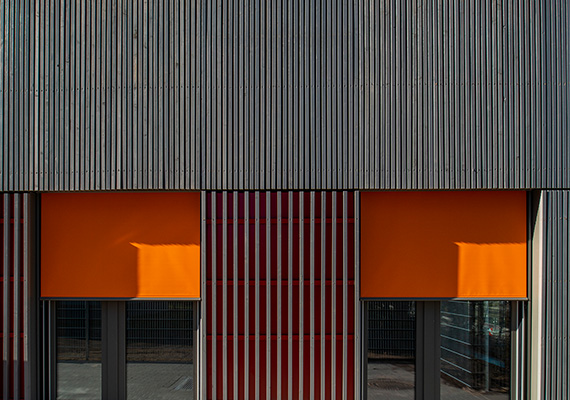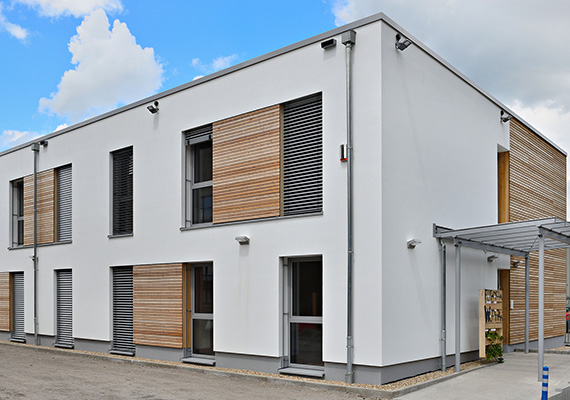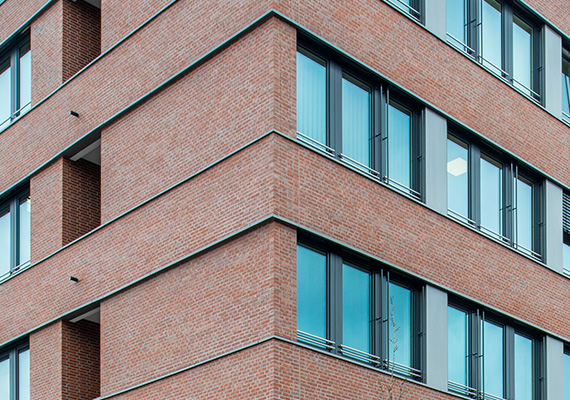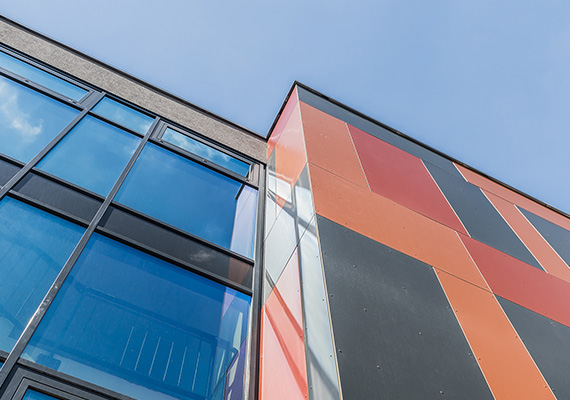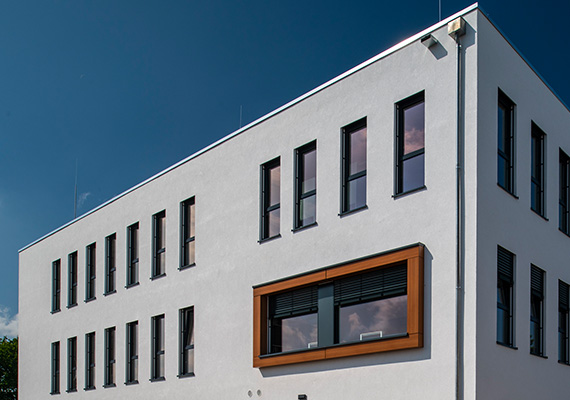Modern facade design with modular construction
The facade defines the appearance of the modular building
Generally speaking, the word facade is understood to mean the external face of a building. The term is also partly used simply to describe the main view of a structure, i.e. the appearance of the building as it is seen from the street. Within this interpretation, the facade acts as the building’s calling card. The facade design plays a major part in defining the look of the building and represents the developer's identity or a company’s corporate design.
The facade is part of the building shell. Depending on the construction, it may even be identical to it if, for example, no additional cladding is placed on the external masonry. As part of the building shell, it plays a visual role but also has other functions, such as regulating and protecting the building or bearing the static load. The facade is therefore important from many points of view.
But no matter what the type of construction is, one thing is true of every facade: It determines the overall appearance and character of the building and is the element that creates the first impression. Developers and planners therefore feel that it is essential to create an attractive facade design.
What are the functions of the facade?
Modular construction offers all the freedom you could want in the choice of facade materials. Alongside plaster on ETICS, curtain facades can be made out of a vast range of materials, such as timber, HPL or metal. Traditional regional designs using clinker bricks or natural materials such as slate or clay are also a possibility. Similarly, post and beam constructions in metal and glass can also be incorporated, allowing more light into entrance areas or staircases, for example. In addition, modular construction allows the facade to be made more visually attractive and exciting with projections and recesses or with cantilevered modules.
The ultimate choice of materials by the developer and planner depends on the individual requirements in terms of durability, maintenance requirements and appearance – and also on the budget. The following provides an overview of the commonest designs.
What design opportunities for the facade does modular construction offer?
Modular construction offers all the freedom you could want in the choice of facade materials. Alongside plaster on ETICS, curtain facades can be made out of a vast range of materials, such as timber, HPL or metal. Traditional regional designs using clinker bricks or natural materials such as slate or clay are also a possibility. Similarly, post and beam constructions in metal and glass can also be incorporated, allowing more light into entrance areas or staircases, for example. In addition, modular construction allows the facade to be made more visually attractive and exciting with projections and recesses or with cantilevered modules.
The ultimate choice of materials by the developer and planner depends on the individual requirements in terms of durability, maintenance requirements and appearance – and also on the budget. The following provides an overview of the commonest designs.
Plaster
Mineral gypsum or lime-cement plasters are frequently used for plaster facades.These consist of mineral particulate materials such as sand or marble gravel. Lime, cement, gypsum or other mixtures act as binders. In addition, additives are used that affect properties such as drying time, air pore formation, flow properties and adhesion. Mineral plasters are mixed with water before application.
Alongside these, synthetic resin plaster is also frequently used. The particles of synthetic resin melt together once the mixing water has evaporated. This creates the necessary strength. Synthetic resin plaster is supplied ready to use.
Maintenance requirements
As a rule, plaster must be repainted after a few years as the effects of the weather and the environment may damage it or cause it to deteriorate.
Costs
Plaster is the cheapest method of covering a facade. However, coloured plasters or highlights in the subsequent paintwork can be used to produce attractive design options very easily.
Timber
Whether a building is given a timber facade depends on the method of construction. In modular construction, a timber facade can be made as a curtain facade without any problem. Combined designs, such as a combination of plaster and timber, can also look very attractive.
Many developers are worried that timber could have a limited durability and rot over time. But, if they are made and maintained properly, even untreated timber facades can be very resistant and durable. On the other hand, timber should not be permanently exposed to moisture. Timber facades are therefore generally designed as ventilated facades. Air can then circulate behind the facade and speed up drying. Untreated timbers fade to grey over time, which only changes the appearance of the wood and can be rectified by regular painting.
Care
Facades made from high-quality timber are highly durable. It they are built properly, they last for at least 30 years and normally much longer. Basically, even untreated timbers do not need painting. The timber ages, changes visually and also warps slightly, but this has no adverse effect on the function of the facade. If a timber facade is painted, the appearance stays the same if the paintwork is regularly renewed, but this increases the maintenance requirement considerably. Repainting may be needed after just five years, depending on the colour and the effects of the weather.
Costs
Timber prices vary considerably – and so the cost of a timber facade will do the same. It is roughly two and a half to three times the cost of a plaster facade. Further costs are incurred if the timber needs to be regularly painted for visual reasons.
Metal or HPL facades
Like timber facades, metal or HPL facades are made as ventilated curtain facades. The advantage of back ventilation is that moisture that has penetrated behind the facade is taken away. This protects the wall behind it from moisture and prevents mould formation. Metal facades are generally made from aluminium. This material is storm-resistant, unbreakable and corrosion-resistant. Aluminium facade panels are available in many colours and shapes.
HPL panels, on the other hand, consist of a pressed timber core with a stable plastic applied on top and underneath. HPL panels are extremely stable and robust.
Care
Because of their surface properties, both metal and HPL panels are particularly resistant to weathering and combine durability with low maintenance requirements. Strong rain, moisture and sunshine have no effect on the facade visually. Dirt cannot stick to the non-porous surfaces, which makes them easier to clean.
Costs
Investing in a ventilated facade made from metal or HPL elements is relatively expensive, and comes to around three times the cost of a plaster facade. This is offset by the minimal costs for cleaning and maintenance over decades.

